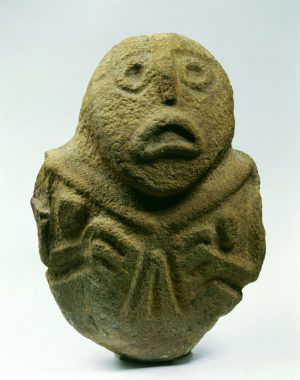More on prehistoric European civilization
As Solomon said, there is nothing new under the sun. And that applies to the development of civilization in S.E. Europe (mostly in the territory of modern Serbia). I wrote yesterday about the elaborate civilization known to archaeologists as Vinca. The degree of modernity in the Vinca culture can be rather startling and the time of its emergence is even more startling. It emerged BEFORE the civilizations of Egypt and Sumeria.
But Vinca did not arise out of nothing. As is usually the case, it evolved from something earlier. And it is an earlier culture I want to mention here: Lepenski Vir. It was obviously much more primitive than Vinca but its remains do entitle it to be called a civilization.
And it is VERY early, much earlier even than Vinca -- starting as early as 9500 BC. So once again we are entitled to say that civilization was a European invention, not an invention from the Middle East. The Middle East is where WRITING that we can decipher originated but the other features of civilization can be found first in "Old Europe"
As a scholarly study of European genetics concluded: "Our study shows that southeastern Europe consistently served as a genetic contact zone between different populations. This role likely contributed to the extraordinary series of cultural innovations that characterize the region"

A fish god sculpture from Lepenski Vir: Half human, half fish. Fishing was a major food source for the inhabitants. Their settlement was on the Danube in a spot good for fishing
There are various theories of where the populations concerned came from but there is little doubt that they were an admixture resulting from several population movements. The admixture was however powerful. Just as the Celts, the Romans, the Anglo-Saxons, the Danes and the Normans fused to produce the very influentil current population of Britain, so the admixture in South Eastern Europe developed into something much more significant than the various genetic streams from which it originated. They started out as farmers but went on to something much more than that.
We know that when one group moves into an already-populated place, the old population is not normally wiped out. At it worst, all the men may be wiped out but the women will be retained to produce children, a highly desired "commodity" where lifespans are short.
And the most recent move into S.E. Europe was of the Slavs, a very successful population that now controls most of Eastern Europe. So one wonders whether the genetics of "Old Europe" have survived the Slavic hegemony. It seems possible but how much has survived? The study of S.E. Europe mentioned above gives a figure of 5% but that is S.E. Europe-wide. In the heartland of Old Europe" -- Serbia -- the percentage could be higher. Serbs do have claims to be descendants of the world's oldest civilization.
Wikipedia has a very extensive and thorough article on Lepinski Vir so I reproduce just its opening paragraphs:
Lepenski Vir located in Serbia, is an important archaeological site of the Mesolithic Iron Gates culture of the Balkans. The latest radiocarbon and AMS data suggests that the chronology of Lepenski Vir spans between 9500/7200–6000 BC. There is some disagreement about when the settlement and culture of Lepenski Vir began, but the latest data indicates that it was between 9500–7200 BC. The late Lepenski Vir (6300–6000 BC) architectural phase saw the development of unique trapezoidal buildings and monumental sculpture. The Lepenski Vir site consists of one large settlement with around ten satellite villages. Numerous piscine sculptures and peculiar architectural remains have been found at the site.
Archaeologist Dragoslav Srejovi?, who first explored the site, said that such large sculptures so early in human history, and the original architectural solutions, define Lepenski Vir as a specific and very early phase in the development of European prehistoric culture. The site was notable for its outstanding level of preservation and the overall exceptional quality of its artifacts. Because the settlement was permanent and planned, with an organized societal life, architect Hristivoje Pavlovi? labeled Lepenski Vir as "the first city in Europe".
https://en.wikipedia.org/wiki/Lepenski_Vir
************************************************
 Eugenio Pacelli, a righteous Gentile, a true man of God and a brilliant Pope
Eugenio Pacelli, a righteous Gentile, a true man of God and a brilliant Pope
No comments:
Post a Comment